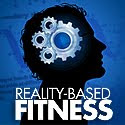If you talk to any serious runner, you’ll almost always arrive at the subject of running shoes. With people who resistance train (or “lift weights”), shoes are hardly part of the discussion with much more attention being paid to specific program design parameters or the latest and greatest “supplement “ being taken. This is a mistake however as shoes are a vital part of safe and effective strength training. The remainder of this post will discuss the various types of shoes worn for resistance training and the pros and cons of each.
The Typical Shoe and Associated Problems
Typically, most recreational lifters (including athletes training with weights) use regular running or cross-training shoes to train in. Function of the shoes being worn is given little to no thought during most people’s lifting program as most will focus on style and appearance instead. The main goal is to look good wearing whatever cool running or athletic shoe that’s currently in style. This is problem because many of the modern running or cross-training shoes have large “cushiony” heels to help dampen the shock of walking, running, and performing various sporting maneuvers. Also, these shoes are typically VERY expensive.

Unfortunately however, during heavy resistance training (i.e. squatting), this type of shoe is akin to standing on giant marshmallows which allows the force being transmitted to be dissipated somewhat in directions that are not conducive to 1) safety, and 2) strength expression. The late sport scientist Mel Siff, had this to say about shoes and weight training on page 461 of his landmark text Supertraining (2000 edition):
“…running shoes or any shock-absorbing shoes suitable for the aerobics class are potentially unsafe in the gymnasium. For instance, compression of any part of the sole during squats, cleans, deadlifts, standing press, good mornings, snatches, pulls and other standing exercises can cause general instability and consequent injury.”
So as you have just read, there are some risks involved with wearing the wrong type of shoes in the gym. So what type of shoe is one to use then?
Some Better Alternatives
When it comes to shoes and strength training, it pays to look at what those involved in strength sports are actually wearing: Olympic-style Weightlifting and Powerlifting come to mind immediately. With Weightlifting, which consists of the Clean & Jerk and the Snatch respectively, you see a shoe being worn that has a non-compressible sole with a slight elevation of the heel. This heel elevation helps with achieving better mobility in the bottom of the clean and the snatch without compromising spinal alignment excessively. It can be very helpful for staying more upright.

The only potential negative aspect of weightlifting shoes is that they do encourage more forward knee travel which adds more stress to the knees. However, this doesn’t seem to be a problem for many Olympic lifters as they don’t seem to suffer from increased incidence of knee injuries compared to other sports despite squatting very deeply and repeatedly in the catch position for the clean and the snatch. In fact, deep squatting is probably one of the best ways to increase knee stability. I personally use Olympic lifting shoes for most of my squatting and pulling exercises and find them an invaluable piece of equipment. Some of the O-lifting shoes can get pretty pricey but if you’re not a competitive Olympic lifter per se, you can find some more affordable models such as Do-Win, a Chinese brand and the models made by VS Athletics. Watch the video below to see the VS Weightlifting shoe in action!
Besides the Olympic Weightlifting shoe option, you could also choose a shoe with a flat and non-compressible sole such as the good old-fashioned canvas Converse Chuck Taylor All-Star shoes. These no-frill shoes are very affordable and available at most shoe stores including Target, which is where I found my latest pair for well under $40!

This shoe is often preferred by Powerlifters due to the flat sole which really helps one to “dig” the heels into the ground as compared to the higher-heeled Olympic-lifting shoes which can tip you forward a bit towards your toes if you are not careful. I personally prefer the Olympic shoes for squatting, but often use the Chuck-Taylor shoe for deadlifting and standing press exercises. Being able to press your feet hard into the ground is also beneficial for activating what is called the “positive support reaction” reflex of the foot. This reflex is stimulated when pressure if directly applied to the plantar surface of your foot which helps stiffen up your entire leg in preparation for loading; something difficult to achieve with today’s squishy-heeled athletic shoes!
There are many other shoes from the world of Powerlifting that I won’t discuss here but if you go the Crain’s Muscle World(http://www.crainsmuscleworld.com/shoes.html), you can see the other options used by powerlifters for both squatting and deadlifting.
I think the theory here (there isn’t a lot of research available on this yet) is that increased tactile sensation leads to better proprioception, which can lead to safer and stronger ground-based lifting. Decreased sensation on the other hand, as found when wearing modern footwear, leads to altered/diminished proprioception which may lead to lessened safety and strength/force output. It’s starting to sound like the closer we can get to barefoot (up to a point), the better subsequent performance we may have. If that’s the case, why not just train barefoot?
The Barefoot Options
On the other extreme of fancy footwear, is no footwear. That’s right, training sans shoes, like the ancient gladiators used to! Unfortunately this doesn’t usually go over too well in most modern training facilities as they may ask you to leave. There are also plenty of hygiene reasons not to train barefoot in most gyms. Also, if you drop a giant Kettlebell, dumbbell or weight plate on your foot or toe, your day will be ruined real fast.
Since training barefoot is not always an option, there are several companies which have created a new industry of “barefoot technology.” The basic idea with these shoes is to simulate and attempt to reproduce the natural sensory mechanical stimulation that occurs with barefoot locomotion. There are several companies that have gotten on board into this growing market but not have done so more interestingly than a company called Vibram (http://www.vibramfivefingers.com/).

These are some of the oddest looking shoes I’ve ever seen, but many of the people I talked to who own them have nothing but great things to say about the shoes (or whatever you want to call them). I’ve yet to try them out myself but probably wouldn’t wear them for anything like really heavy squatting or deadlifting; but I could be wrong. My guess is that they would be awesome for lighter lifting exercises like repeated Kettlebell work, calisthenics, or even tempo running on grass or trails.
Conclusion and Take-Home Points
Well, there you have it; an interesting foray into the world of footwear for resistance training. My personal preference is to use Chuck-Taylor All-Star shoes and Olympic lifting shoes for most of my heavy resistance training. For Kettlebell work and light bodyweight callisthenic work I prefer the Chuck-Taylor shoes or my Addidas Martial Arts shoes that are slip-ons. I know some other lifters who like the Adiddas soccer "Samba" shoe as well.
I haven’t tried the other Powerlifting types of shoes nor the Vibram five-finger shoes, but probably will try the Vibram's out after hearing how my twin brother Franz (who just bought a pair) does in them. Since we have identical genetics, it is a fair bet that if it makes him feel good, it may offer my some benefit as well since we have many of the same muscle imbalances and orthopedic concerns (like problems with our big toes)!
The bottom line here is that traditional running, walking, or cross-training types of shoes are not appropriate for heavy resistance training. When I say “heavy” I’m not implying that you have to be a competitive Powerlifter or Weightlifter to benefit from their shoe styles. Heavy is relative to one’s abilities; but all people who wish to get stronger should ensure both safety and effectiveness in their training; and footwear is often a much neglected component to the training program! To finish this blog, you can watch the video of me summing up much of what I've already said; enjoy!






